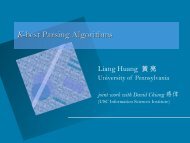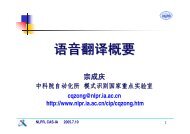Machine Translation with Lattices and Forests
Machine Translation with Lattices and Forests
Machine Translation with Lattices and Forests
Create successful ePaper yourself
Turn your PDF publications into a flip-book with our unique Google optimized e-Paper software.
(0, 2, NR) (2, 3, CC) (3, 5, NR) (5, 6, VV) (6, 8, NN) (8, 9, NN)<br />
0 c 0 :Bù 1 c 1 :shí 2 c 2 :yǔ 3 c 3 :Shā 4 c 4 :lóng 5 c 5 :jǔ 6 c 6 :xíng 7 c 7 :tǎo 8 c 8 :lùn<br />
9<br />
(2, 3, P)<br />
(5, 7, VV) (7, 9, NN)<br />
Figure 2: The lattice of the example:“ Bù shí yǔ Shā lóng jǔ xíng tǎo lùn.” The solid lines show the 1-best<br />
result, which is wrong.<br />
Jiang et al. (2008b) stress the problems in reranking<br />
phase. Both lattices <strong>and</strong> forests have become<br />
popular in machine translation literature.<br />
However, to the best of our knowledge, previous<br />
work only focused on one module at a time. In this<br />
paper, we investigate the combination of lattice<br />
<strong>and</strong> forest (Section 2), as shown in Figure 1(b).<br />
We explore the algorithms of lattice parsing (Section<br />
3.2), rule extraction (Section 4) <strong>and</strong> decoding<br />
(Section 5). More importantly, in the decoding<br />
step, our model can search among not only more<br />
parse-trees but also more segmentations encoded<br />
in the lattice-forests <strong>and</strong> can take into account all<br />
the probabilities of segmentations <strong>and</strong> parse-trees.<br />
In other words, our model postpones the disambiguition<br />
of segmentation <strong>and</strong> parsing into the final<br />
translation step, so that we can do global search<br />
for the best segmentation, parse-tree <strong>and</strong> translation<br />
in one step. When we integrate a lattice into<br />
a forest system, medium-scale experiments (Section<br />
6) show another improvement of +0.9 BLEU<br />
points over a state-of-the-art forest-based system.<br />
2 Compact Structures<br />
A word lattice (Figure 2) is a compact representation<br />
of all the possible of segmentations <strong>and</strong> POS<br />
tags, while a parse forest (Figure 5) is a compact<br />
representation of all parse trees.<br />
2.1 Word Lattice<br />
For a given input sentence C = c 0 ..c n−1 , where<br />
c i denotes a character at position i, <strong>and</strong> n is the<br />
length of the sentence.<br />
A word lattice (Figure 2), or lattice in short, is<br />
a set of edges L, where each edge is in the form<br />
of (i, j, X), which denotes a word of tag X, covering<br />
characters c i through c j−1 . For example, in<br />
Figure 2, (7, 9, NN) is a noun “tǎolùn” of two characters.<br />
The lattice in Figure 2 shows result of the example:“<br />
Bù shí yǔ Shā lóng jǔ xíng tǎo lùn ”.<br />
One ambiguity comes from the POS tag of word<br />
“yǔ” (preposition (P) or conjunction (CC)). The<br />
other one is the segmentation ambiguity of the last<br />
four characters, we can segment into either “jǔ<br />
xíngtǎo lùn” (solid lines), which means lift, begging<br />
<strong>and</strong> argument separately for each word or<br />
“jǔxíng tǎolùn” (dashed lines), which means hold<br />
a discussion.<br />
lift begging argument<br />
5 jǔ 6 xíng 7 tǎo 8 lùn 9<br />
hold<br />
a discussion<br />
The solid lines above (<strong>and</strong> also in Figure 2)<br />
show the 1-best result, which is obviously wrong.<br />
If we feed it into the next modules in the SMT<br />
pipeline, parsing <strong>and</strong> translation will be become<br />
much more difficult, since the segmentation is not<br />
recoverable. So it is necessary to postpone error<br />
segmentation decisions to the final translation<br />
step.<br />
2.2 Parse Forest<br />
In parsing scenario, a parse forest (Figrure 5), or<br />
forest for short, can be formalized as a hypergraph<br />
H, a pair 〈V, E〉, where node v ∈ V is in<br />
the form of X i,j , which denotes the recognition of<br />
nonterminal X spanning the substring c i:j−1 from<br />
positions c i through c j−1 . Each hyperedge e ∈ E<br />
is a pair 〈tails(e),head(e)〉, where head(e) ∈ V<br />
is the consequent node in an instantiated deductive<br />
step, <strong>and</strong> tails(e) ∈ (V ) ∗ is the list of antecedent<br />
nodes.<br />
For the following deduction:<br />
NR 0,2 CC 2,3 NR 3,5<br />
NP 0,5 (*)









